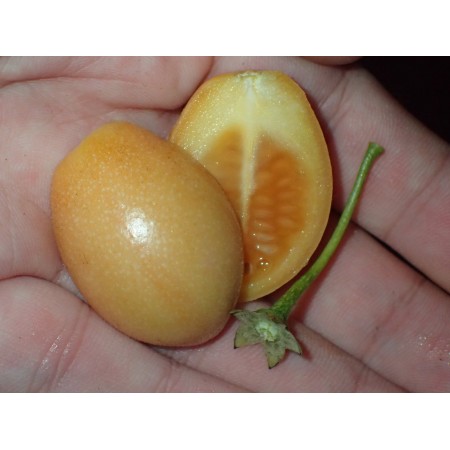








Guava Tamarillo (Solanum diploconos) (tree tomato species) - 7 seeds
Guava Tamarillo (Cyphomandra fragrans, syn. Solanum diploconos), also called “Glossy-leaved Tamarillo”. It is native to south and south-east Brazil (Minas Gerais, Espírito Santo, São Paulo, Rio de Janeiro, Paraná, Santa Catarina, Rio Grande do Sul) and adjacent Argentina and Paraguay. There were attempts of its cultivation as fruit tree on New Zealand. It has very, very ornamental leaves and very thick trunk (about 6-12 cm = 2-5 inch diameter in down part). This small tree with umbrella-like shape of upper branches can reach about 1,5-2,5 m (= 5-8 ft) if grown in medium size pots (or to 4 m = 13 ft in nature). The leaves of juvenile plants are deeply lobed. Older ones are entire. It is not widely known that this species is also very resistant to frost [in winter 2016/17 it survived in my cool cellar the permanent constant temperature about (– 1) C degree (= 30 F degree) by at least 1,5 month and short periods with lower temperatures – I am not sure, but probably - to about (-5) – (-8) C degree = 18-23 F degree]. Although the plants were damaged by frost but 3 (of all 4 which I had) of them survived this winter and resprouted after a cutting (shorting died shoots) in spring. These plants need to have completely dry soil in winter to they could survive the frost. But it is very drought resistant and can survive 4 months without any watering in its native range and even longer drought if kept in cold temperatures inside (in cool cellar etc.) in winter in temperate areas (my plants survived more than 6 months in leaf-less state). It is also resistant to some shade and water-lodging (if grown in pots). As pot plant it can be so-called “iron-plant” – it can survive almost every bad conditions. In cool areas this species is deciduous. In winter the leaves and thin branches are dying. It creates very ornamental flowers and next very numerous small (about 2-4cm = 0,8-1,6 inch long), ovate, yellow delicious fruits with exotic aroma (they taste similar to passion fruit, but usually acid). Guava Tamarillo can be easily propagated by seeds (sow surface) or cuttings (with heel). This species is very difficult to buying and rare in wild state - it is classified as 'Near Threatened' in the IUCN Red List of Threatened Species (2011). This species was used by us to creation hybrids....if you would like to see more info about our breeding working with Tamarillos crossings, there is available our article in Internet: Wojciech Maksymilian Szymański & Iwona Ziółkowska "Hybrids of Solanum corymbiflorum and S. diploconos(Solanaceae) – a hope for new commercial varieties of edible fruits" / "Híbridos de Solanum Corymbiflorum e S. diploconos (Solanaceae) – uma alternativa paranovas cultivares comerciais de frut as comestíveis" Vista do Híbridos de Solanum Corymbiflorum e S. diploconos (Solanaceae) – uma alternativa para novas cultivares comerciais de frutas comestíveis (udesc.br) https://www.revistas.udesc.br/index.php/agroveterinaria/article/view/21311/13799 Rev. Ciênc. Agrovet., Lages, SC, Brasil (ISSN 2238-1171) DOI: 10.5965/223811712042021342 Revista de Ciências Agroveterinárias 20(4): 2021 Universidade do Estado de Santa Catarina
In sale package of 7 fresh seeds. The seeds should be sown surface and kept gently moist and warm. They usually germinates within 1-1,5 month.
Data sheet